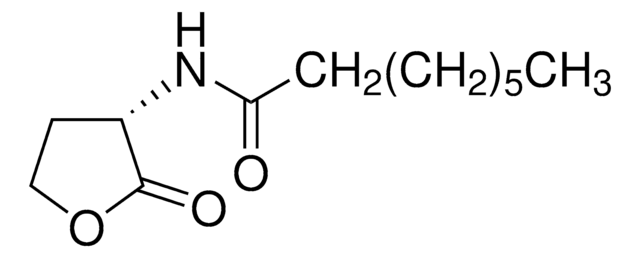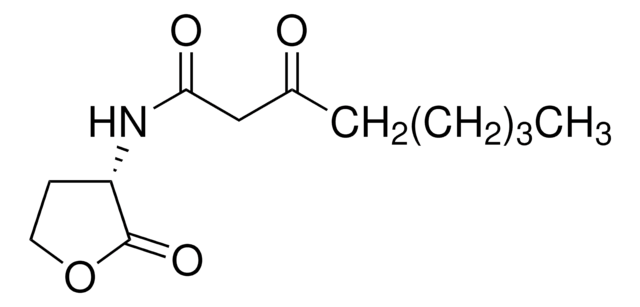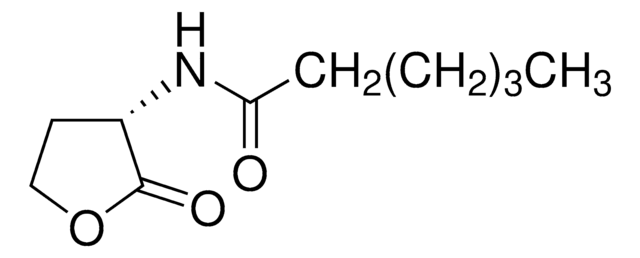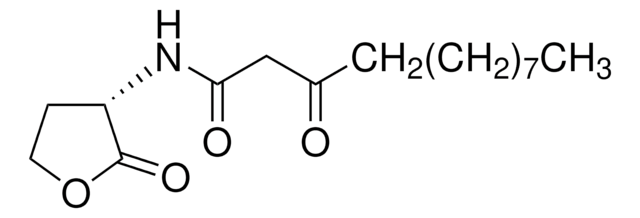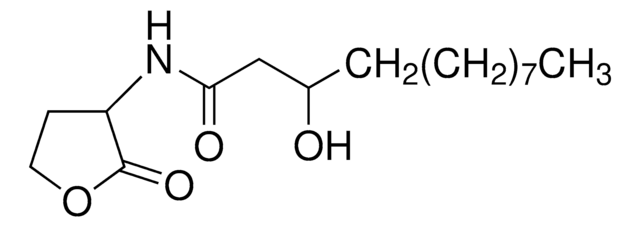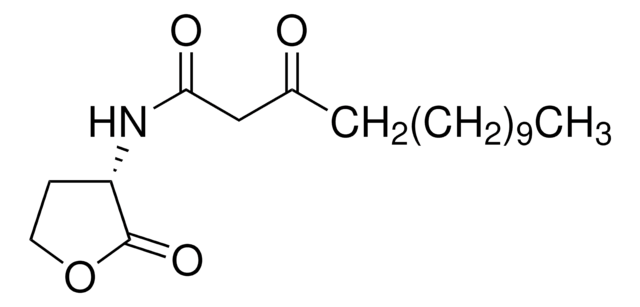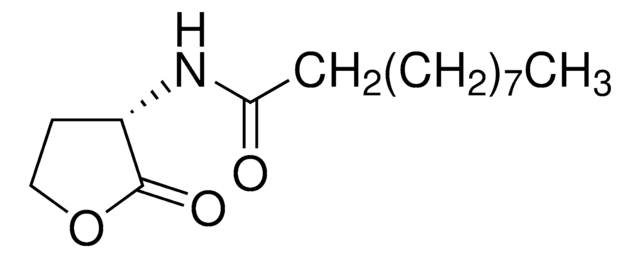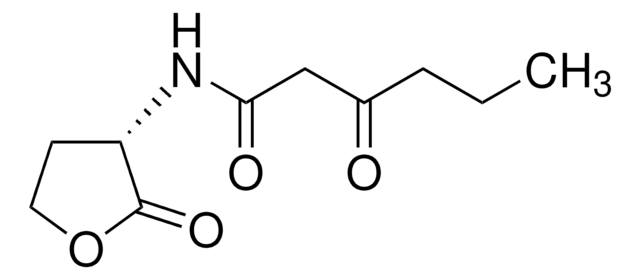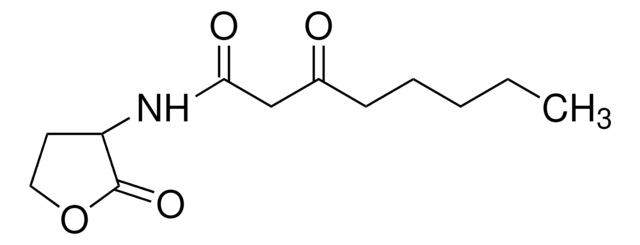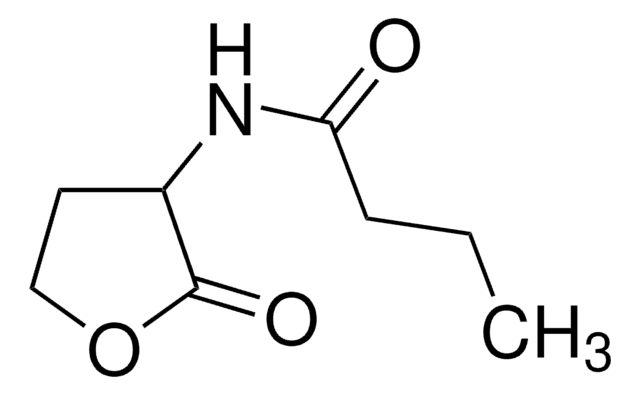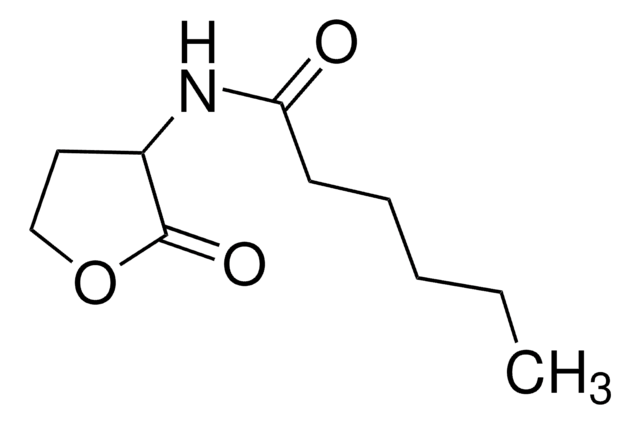68873
N-(3-Hydroxydecanoyl)-DL-homoserine lactone
Synonyme(s) :
3-Hydroxy-N-(tetrahydro-2-oxo-3-furanyl)decanamide, N-[(RS)-3-Hydroxydecanoyl]-DL-homoserine lactone
Se connecterpour consulter vos tarifs contractuels et ceux de votre entreprise/organisme
About This Item
Formule empirique (notation de Hill) :
C14H25NO4
Numéro CAS:
Poids moléculaire :
271.35
Numéro MDL:
Code UNSPSC :
41116134
ID de substance PubChem :
Nomenclature NACRES :
NA.25
Produits recommandés
Forme
powder
Température de stockage
−20°C
Chaîne SMILES
O=C(CC(O)CCCCCCC)NC1C(OCC1)=O
InChI
1S/C14H25NO4/c1-2-3-4-5-6-7-11(16)10-13(17)15-12-8-9-19-14(12)18/h11-12,16H,2-10H2,1H3,(H,15,17)
Clé InChI
DOICJCCMIBBSOO-UHFFFAOYSA-N
Actions biochimiques/physiologiques
N-(3-Hydroxydecanoyl)-DL-homoserine lactone is a member of N-acyl-homoserine lactone family. N-Acylhomoserine lactones (AHL) regulate gene expression in gram-negative bacteria, such as Echerichia and Salmonella, and are involved in quorum sensing, cell to cell communication among bacteria; for reviews see. Bacterial intercellular communication has become a target for the development of new anti-virulence drugs, and a research focus for the prevention of biofilm formation.
Quorum-sensing signal generation
Code de la classe de stockage
11 - Combustible Solids
Classe de danger pour l'eau (WGK)
WGK 3
Point d'éclair (°F)
Not applicable
Point d'éclair (°C)
Not applicable
Faites votre choix parmi les versions les plus récentes :
Déjà en possession de ce produit ?
Retrouvez la documentation relative aux produits que vous avez récemment achetés dans la Bibliothèque de documents.
Les clients ont également consulté
M R Parsek et al.
Proceedings of the National Academy of Sciences of the United States of America, 96(8), 4360-4365 (1999-04-14)
Acyl homoserine lactones (acyl-HSLs) are important intercellular signaling molecules used by many bacteria to monitor their population density in quorum-sensing control of gene expression. These signals are synthesized by members of the LuxI family of proteins. To understand the mechanism
Barbara Thallinger et al.
Biotechnology journal, 8(1), 97-109 (2013-01-03)
With the increasing prevalence of antibiotic resistance, antimicrobial enzymes aimed at the disruption of bacterial cellular machinery and biofilm formation are under intense investigation. Several enzyme-based products have already been commercialized for application in the healthcare, food and biomedical industries.
Margrith E Mattmann et al.
The Journal of organic chemistry, 75(20), 6737-6746 (2010-08-03)
Bacteria use small molecule signals to access their local population densities in a process called quorum sensing (QS). Once a threshold signal concentration is reached, and therefore a certain number of bacteria have assembled, bacteria use QS to change gene
Regulation of gene expression by cell-to-cell communication: acyl-homoserine lactone quorum sensing.
C Fuqua et al.
Annual review of genetics, 35, 439-468 (2001-11-09)
Quorum sensing is an example of community behavior prevalent among diverse bacterial species. The term "quorum sensing" describes the ability of a microorganism to perceive and respond to microbial population density, usually relying on the production and subsequent response to
Dilani Senadheera et al.
Advances in experimental medicine and biology, 631, 178-188 (2008-09-17)
Streptococcus mutans is the primary causative agent involved in dental caries in humans. Among important virulence factors of this pathogen, its ability to form and sustain a polysaccharide-encased biofilm (commonly called dental plaque) is vital not only to its survival
Notre équipe de scientifiques dispose d'une expérience dans tous les secteurs de la recherche, notamment en sciences de la vie, science des matériaux, synthèse chimique, chromatographie, analyse et dans de nombreux autres domaines..
Contacter notre Service technique